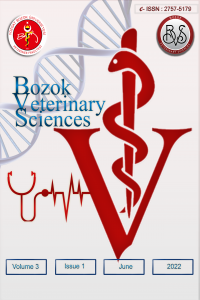Zoonotik Bulaşı olan İki Sarkoptik Uyuzlu Köpeğin Sağaltımında Heterojen Deri Mikrobiyota Transplantasyonu
: Köpek, Mikrobiyom manuplasyonu, Mikrobiyom modülasyonu, Deri mikrobiyota transferi, : Dog, Microbiome manuplation, Microbiome modulation, Skin microbiota transplantation
Heterologue Skin Microbiota Transplantation for Treatment of Sarcoptic Manges in Two Dogs with Zoonotic Transmission
: Köpek, Mikrobiyom manuplasyonu, Mikrobiyom modülasyonu, Deri mikrobiyota transferi, : Dog, Microbiome manuplation, Microbiome modulation, Skin microbiota transplantation,
___
- 1. Wanke I, Steffen H, Christ C, Krismer B, Götz F, Peschel A, Schittek B. Skin commensals amplify the innate immune response to pathogens by activation of distinct signaling pathways. Journal of Investigative Dermatology 2011; 131(2): 382-390. Doi: https://doi.org/10.1038/jid.2010.328.
- 2. Zeeuwen PL, Boekhorst J, van den Bogaard EH, de Koning HD, van de Kerkhof P, Saulnier DM, Timmerman HM. Microbiome dynamics of human epidermis following skin barrier disruption. Genome Biology 2012; 13(11): 1-18. Doi: https://doi.org/10.1186/gb-2012-13-11-r101.
- 3. Swe PM, Zakrzewski M, Kelly A, Krause L, Fischer K. Scabies mites alter the skin microbiome and promote growth of opportunistic pathogens in a porcine model. PLOS Neglected Tropical Diseases 2014; 8: e2897. Doi: https://doi.org/10.1371/journal.pntd.0002897.
- 4. Walton SF, Holt DC, Currie BJ, Kemp DJ. Scabies: new future for a neglected disease. Advances in Parasitology 2004; 57(57): 309-76.
- 5. Hengge UR, Currie BJ, Jäger G, Lupi O, Schwartz RA. Scabies: a ubiquitous neglected skin disease. The Lancet Infectious Diseases 2006; 6(12): 769-779.
- 6. Almberg ES, Cross PC, Dobson AP, Smith DW, Hudson PJ. Parasite invasion following host reintroduction: a case study of Yellowstone's wolves. Philosophical Transactions of the Royal Society B: Biological Sciences 2012; 367(1604): 2840-2851. Doi: https://doi.org/10.1098/rstb.2011.0369.
- 7. Fraser TA, Charleston M, Martin A, Polkinghorne A, Carver S. The emergence of sarcoptic mange in Australian wildlife: an unresolved debate. Parasites & Vectors 2016; 9(1): 1-11.
- 8. Kong HH, Oh J, Deming C, Conlan S, Grice EA, Beatson MA, Segre JA. Temporal shifts in the skin microbiome associated with disease flares and treatment in children with atopic dermatitis. Genome Research 2012; 22(5): 850-859. Doi: 10.1101/gr.131029.111.
- 9. Rodrigues Hoffmann A, Patterson AP, Diesel A, Lawhon SD, Ly HJ, Stephenson CE, Suchodolski JS. The skin microbiome in healthy and allergic dogs. PloS One, 2014; 9(1): e83197. Doi: https://doi.org/10.1371/journal.pone.0083197.
- 10. Williams MR, Gallo RL. The role of the skin microbiome in atopic dermatitis. Current Allergy AND Asthma Reports 2015; 15(11): 1-10. Doi: https://doi.org/10.1007/s11882-015-0567-4.
- 11. Bradley CW, Morris DO, Rankin SC, Cain CL, Misic AM, Houser T, Grice EA. Longitudinal evaluation of the skin microbiome and association with microenvironment and treatment in canine atopic dermatitis. Journal of Investigative Dermatology 2016; 136(6): 1182-1190. Doi: https://doi.org/10.1016/j.jid.2016.01.023.
- 12. Callewaert C, Knödlseder N, Karoglan A, Güell M, Paetzold B. Skin microbiome transplantation and manipulation: Current state of the art. Computational and Structural Biotechnology Journal 2021; 19: 624-631. Doi: https://doi.org/10.1016/j.csbj.2021.01.001.
- 13. Whitehall J, Kuzulugil D, Sheldrick K, Wood A. Burden of paediatric pyoderma and scabies in N orth W est Q ueensland. Journal of Paediatrics and Child Health 2013; 49(2): 141-143. Doi: https://doi.org/10.1111/jpc.12095.
- 14. McCarthy JS, Kemp DJ, Walton SF, Currie BJ. Scabies: more than just an irritation. Postgraduate Medical Journal 2004; 80(945): 382-387.
- 15. Wolina U, Hipler UC, Nenoff P. Trichobacteriosis, erythrasma and pitted keratolysis–the spectrum of non-diphtheroid Corynebacteria. Romanian Journal of Clinical and Experimental Dermatology, 2017; 4(2).
- 16. Swe PM, Fischer K. A scabies mite serpin interferes with complement-mediated neutrophil functions and promotes staphylococcal growth. PLoS Neglected Tropical Diseases 2014; 8(6): e2928. Doi: https://doi.org/10.1371/journal.pntd.0002928.
- 17. Mika A, Reynolds SL, Pickering D, McMillan D, Sriprakash KS, Kemp DJ, Fischer K. Complement inhibitors from scabies mites promote streptococcal growth–a novel mechanism in infected epidermis?. PLoS neglected Tropical Diseases 2012; 6(7): e1563. Doi: https://doi.org/10.1371/journal.pntd.0001563.
- 18. Bergström FC, Reynolds S, Johnstone M, Pike RN, Buckle AM, Kemp DJ, Blom AM. Scabies mite inactivated serine protease paralogs inhibit the human complement system. The Journal of Immunology 2009; 182(12): 7809-7817. Doi: https://doi.org/10.4049/jimmunol.0804205.
- 19. Grice EA, Kong HH, Conlan S, Deming CB, Davis J, Young AC, Segre JA. Topographical and temporal diversity of the human skin microbiome. Science 2009; 324(5931): 1190-1192. Doi: 10.1126/science.117170.
- 20. Myles IA, Earland NJ, Anderson ED, Moore IN, Kieh MD, Williams KW, Datta SK. First-in-human topical microbiome transplantation with Roseomonas mucosa for atopic dermatitis. JCI Insight 2018; 3(9). Doi: 10.1172/jci.insight.120608.
- 21. Paetzold B, Willis JR, Pereira de Lima J, Knödlseder N, Brüggemann H, Quist S. R, Güell M. Skin microbiome modulation induced by probiotic solutions. Microbiome 2019; 7(1), 1-9. Doi: https://doi.org/10.1186/s40168-019-0709-3.
- 22. Ito Y, Amagai M. Controlling skin microbiome as a new bacteriotherapy for inflammatory skin diseases. Inflammation and Regeneration 2022; 42(1): 1-13. Doi: https://doi.org/10.1186/s41232-022-00212-y.
- 23. Perin B, Addetia A, Qin X. Transfer of skin microbiota between two dissimilar autologous microenvironments: A pilot study. PLoS One 2019; 14(12): e0226857. Doi: https://doi.org/10.1371/journal.pone.0226857.
- Yayın Aralığı: Yılda 2 Sayı
- Başlangıç: 2020
- Yayıncı: Yozgat Bozok Üniversitesi
Kadır BOZUKLUHAN, Oguz MERHAN, Fatih BUYUK, Enes AKYÜZ, Tahir GEZER, Hale ERGİN EĞRİTAĞ, Gürbüz GOKCE
Marwa JAWAD, Zahraa MOHAMMED, Firas ALALİ, Saeed EL-ASHRAM, Asaad Sh. M. ALHESNAWİ
Medikal Ozonun Deri Lezyonlarının İyileşmesi Üzerine Etkileri
Nevzat Emre ASLAN, Hanıfı EROL
Kerem URAL, Hasan ERDOĞAN, Songül ERDOĞAN
Siirt Otlu Peynirinin Teknik, Fiziksel, Kimyasal ve Mikrobiyolojik Analizleri
